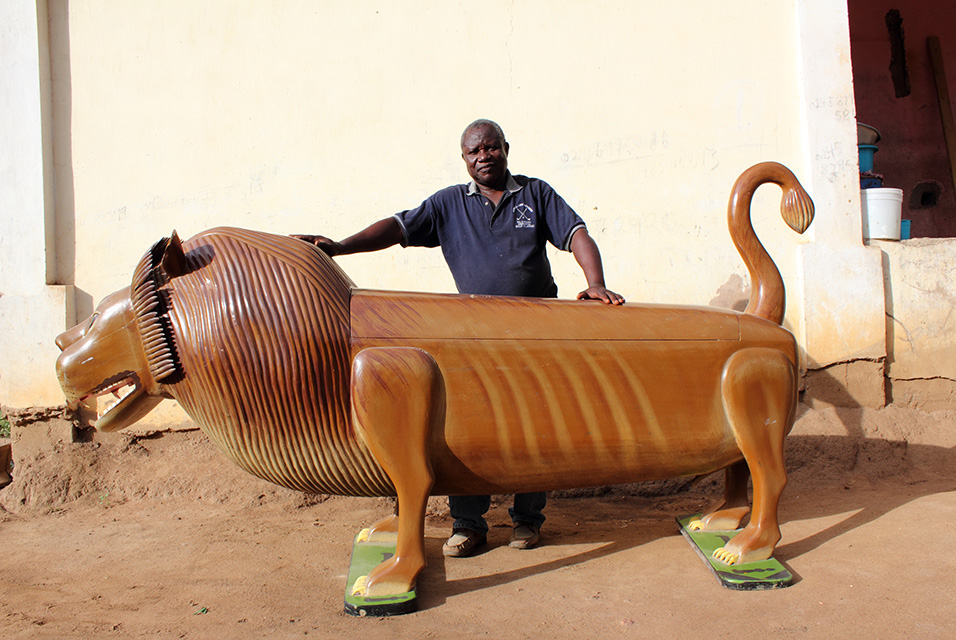Large-scale sculptures by Ghanaian artist Paa Joe on view at High Museum of Art

Artdaily_ATLANTA, GA.- This spring, the High Museum of Art presents “Paa Joe: Gates of No Return” (Feb. 29–May 31, 2020), an exhibition organized by the American Folk Art Museum featuring a series of seven large-scale, painted wood architectural sculptures representing Gold Coast fortresses, which served as way stations for millions of Africans sold into slavery and sent to the Americas and the Caribbean between the 16th and 19th centuries.
The sculptures were created by Ghanaian artist and master craftsman Joseph Tetteh Ashong (b. 1947), also known as Paa Joe, who is the most celebrated fantasy coffin maker of his generation. Recalling his figurative coffins—or abeduu adekai (“proverb boxes”)—these architectural models allude to the lives of the dead in their forms and motifs. Though not actual coffins, the sculptures in the exhibition refer to the fortress sites as embodying vessels of death. Once enslaved people were forced through these “Gates of No Return,” they started an irreversible and perilous journey during which many perished and those who survived suffered the spiritual death of permanent displacement and dehumanization.
The seven imposing sculptures selected for the exhibition are among a group of 13 models that were commissioned from Paa Joe in 2004 and 2005 by the late artist, collector and art dealer Claude Simard. The generous scale and high contrast of these sculptures evoke the style of Paa Joe’s fantasy coffins. The artist created this body of work after several visits to each of the Gold Coast sites, which include the Christiansborg Castle in Accra and Fort Gross-Friedrichsburg in Princes Town.
In addition to the seven sculptures on view, the exhibition features archival documents and recordings that provide context for the artist’s creative process and give points of entry into the history of these charged historical sites, including photographs and short films by award-winning filmmaker Benjamin Wigley and art historian Nana Oforiatta-Ayim, curator of Ghana’s 58th pavilion for the 2019 Venice Biennale.
As the first venue for this critically acclaimed exhibition in the American South, the High is presenting programs and information that connect Paa Joe’s haunting sculptures with the region’s history of slavery.
“In a sculptural language informed by his many years of making fantasy coffins, Paa Joe has made it possible for our audiences to encounter places whose histories may not be as well-known as they should be,” said Katherine Jentleson, the High’s Merrie and Dan Boone curator of folk and self-taught art. “Standing before his replicas is an experience that will be an emotional one for our audiences, especially as we strive to connect these places with the historic sites related to the transatlantic slave trade that surround us in the southeastern United States.”
“Paa Joe: Gates of No Return” is presented on the second level of the High’s Anne Cox Chambers Wing.
Paa Joe was 15 years old when he began a 12-year apprenticeship in 1962 with his mother’s cousin Kane Kwei (1922–1992), who is known to be the first to popularize the use of figurative coffins for burial. Still active, Paa Joe is based in the greater Accra region and has been building coffins since the 1970s, gaining recognition as being the most celebrated living artist of Ghana in the genre. In 2018, the Detroit Institute of Arts honored him with the 2018 African Arts Recognition Award, which underlines his contributions to contemporary culture. Paa Joe has received international recognition in exhibitions since the 1980s, including the 1989 seminal “Magicians of the Earth” at the Centre Pompidou, Paris, and other presentations at the British Museum, the Victoria and Albert Museum in London and the Brooklyn Museum, among others. In 2016, he was the subject of a documentary film, “Paa Joe & The Lion” (Benjamin Wigley, ARTDOCS Ltd). Some of his coffins from American collections were featured in the 2018 exhibition “Shapes of the Ancestors: Bodies, Animals, Art, and Ghanaian Fantasy Coffins” at the Mathers Museum of World Cultures, Indiana University, Bloomington.
